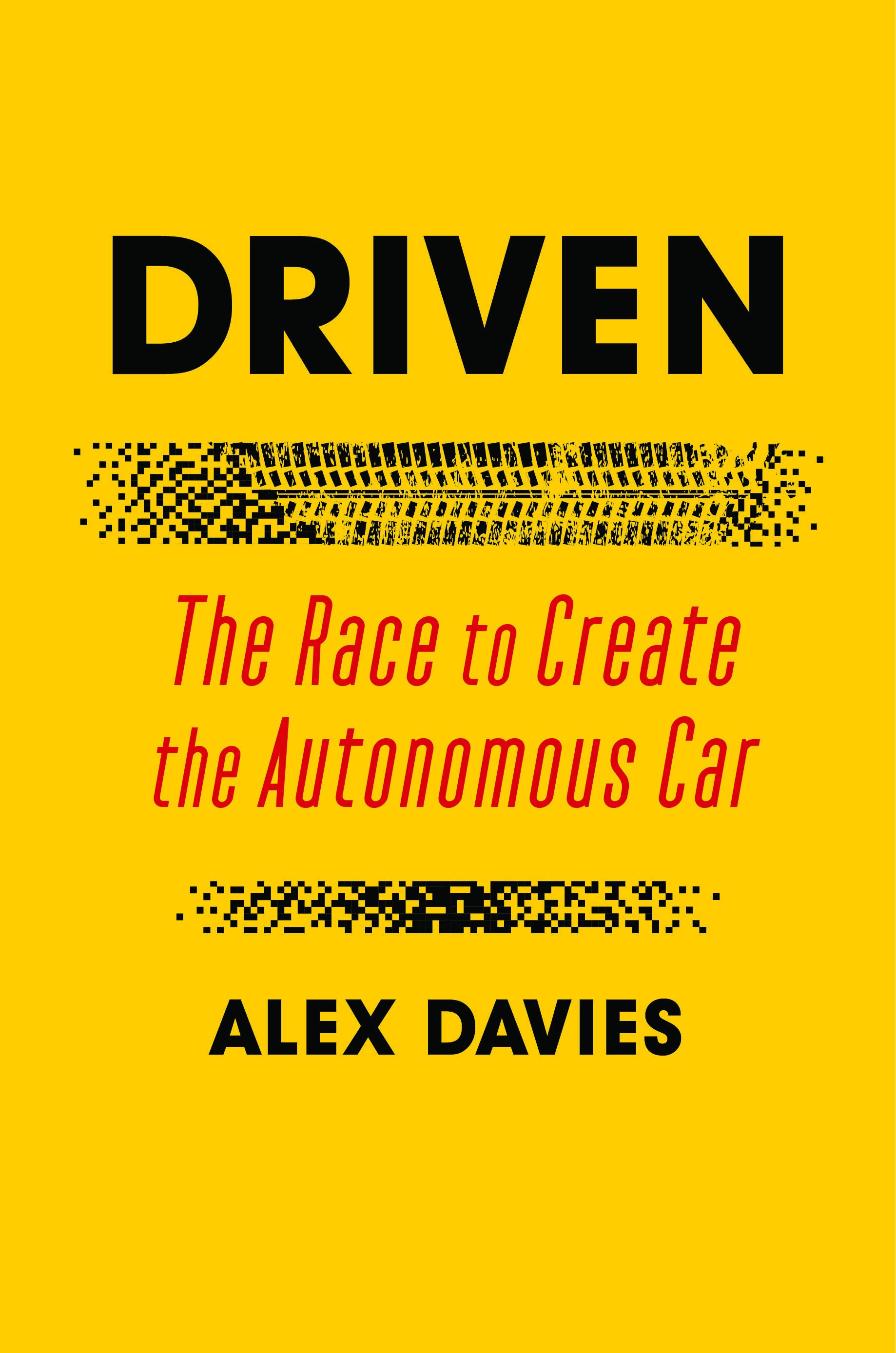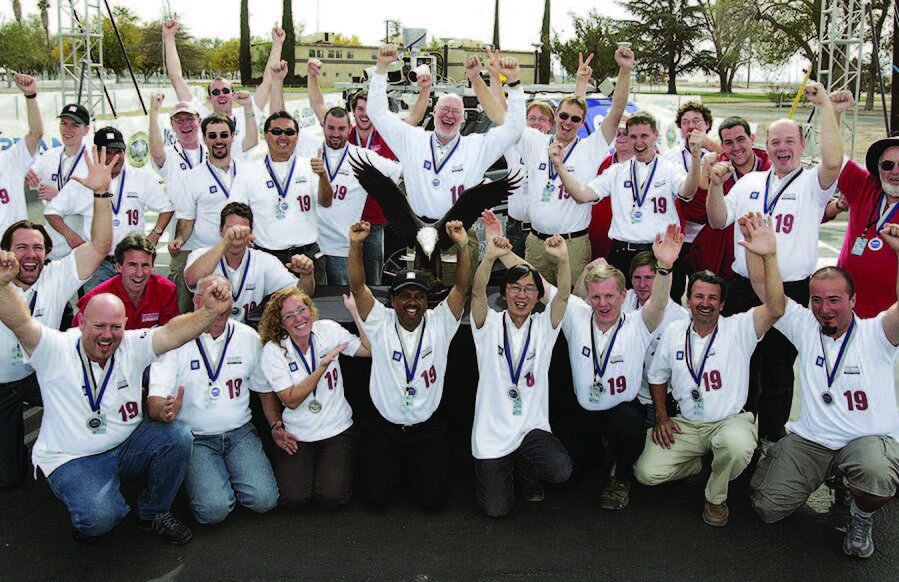Book Excerpt:
The following is an excerpt from the book DRIVEN: The Race to Create the Autonomous Car, by Alex Davies, which tells the story of the quest to develop the driverless car. The story begins with the events leading up to the Defense Advanced Research Projects Agency (DARPA) 2004 Grand Challenge, which the CMU Tartan Racing team won, lifting CMU and Pittsburgh as key players in the world of autonomous vehicles.
Boss, winner of the 2004 DARPA Grand Challenge
By January of 2007, with ten months to go before the Urban Challenge, Tartan Racing was well on its way. Its twin robots were running slalom courses amid the rubble and dirt mounds of the steel mill site, with the Pittsburgh skyline visible in the distance. They had completed multi-checkpoint missions and begun running through those devilish four-way stops. With the harsh winter setting in, it was time to head west. Not to the Nevada Automotive Test Center this time, but to the Phoenix suburb of Mesa, Arizona. Tartan’s partner, General Motors, had invited them to its hot weather proving ground. At the expansive, well-equipped facility, the team took over an available workshop and fell into a familiar, brutal work schedule: wake up, work, eat whatever food someone hauled in, sleep, repeat. Six weeks before the start of the qualifying round, they decamped again. Back in 2003, racer Chip Ganassi had taught the Red Team to practice the way you race. [Tech lead Chris] Urmson figured DARPA was likely to host the Urban Challenge on a military base, since it would never be able to close down public streets for a robot melee, and he thought it would be nice to get away from GM’s overly bureaucratic bailiwick. A quick internet search for disused bases led him to California’s Central Valley.
A two-hour drive southeast of San Francisco, Castle Air Force Base had opened in 1941 as a flight school for American pilots headed into battle over Europe and the Pacific. When it closed in 1995, some of its nearly three thousand acres went to an air museum. Another chunk hosted a high-security prison. The rest lay mostly fallow, the soil contaminated by the fuels, oils, and chemicals that come with keeping warbirds in the air. But it had a large street network, a hangar to work out of, and room to run wild. So Urmson struck a deal with local officials, and the dozen or so core members of the team made camp in the abandoned officers’ quarters. Conditions were grim. The place teemed with black widow spiders. One room contained a mess of feathers and bones a lunching coyote (or something) had left behind. When Mike Taylor, a Caterpillar engineer embedded with the team, noticed a pain in his foot one day, he took off his boot to find a pair of puncture marks in his pinky toe. His best guess was that a bat must have bit him in his sleep. On the advice of his father, a veterinarian, he called up the California Natural Resources Agency and asked if they had reports of rabid bats in the region. The answer came back in a worryingly grim tone: “Rabid bats are everywhere.” Taylor headed to a doctor, took a rabies shot to the butt cheek, and went back to work.
The occasional wild animal interaction, in any case, wasn’t as scary as the ordeals Bob Bittner dreamed up for Boss. An army and navy veteran who’d once worked as a foreman at the Pittsburgh steel mill the team had turned into a test site, Bittner didn’t write code, but he’d worked with enough computing systems to know how to look for their weaknesses. As the Tartan testing lead, he created a twentyfive-page playbook that mimicked everything the govvies might throw at Boss: fourway stops where another vehicle went out of order, parking lots barely wide enough for the SUV to turn around, labyrinths that tested the bot’s ability to navigate. To run these scenarios, team members would drive their rental cars or the handful of vehicles GM had sent over, rearranging the cones and barrels that represented assorted obstacles and the overturned plastic gutters that stood in for curbs. For the riskier tests, they used an inflatable car (nicknamed Stanley) on rollers. Bittner ended each session with a half-hour “free for all,” where everyone did whatever he could think of to make Boss break a rule or otherwise trip up. Here, they were less worried about what DARPA concocted than what other teams’ imperfect robots might do. They’d drive straight at the Tahoe, go the wrong direction down a one-way road, pull up alongside it and juke into its lane, and challenge it with whatever other nonsense they could imagine.
Those tests turned up software bugs and key information about where Boss was vulnerable. They also revealed the unexpected results that changes to a big, interconnected system can have, like an algorithm focused on intersection precedence that somehow deleted Boss’s ability to execute three-point turns. In the final weeks before the race, the team turned its attention to hardening its system, and tracking down errors in the voluminous code. Sitting at the desks they’d set up in an old hangar, they celebrated each squashing of a software bug by hitting a red plastic button (akin to the Staples “That Was Easy” button) that played the Imperial March, the Star Wars tune that accompanied the approach of Darth Vader. Every repeat of the leitmotif signified another step toward the victory that had eluded them in the desert.
Excerpt from DRIVEN by Alex Davies.
Copyright ©2021 by Alex Davies.
Reprinted by permission of Simon & Schuster, Inc, NY.
The Tartan Racing team celebrates victory in the 2004 DARPA Grand Challenge.




